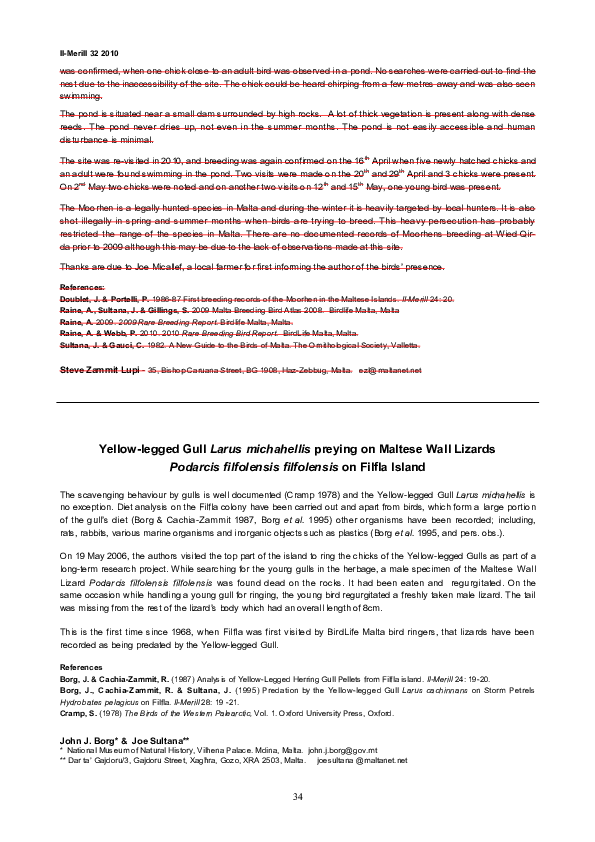Academia.edu no longer supports Internet Explorer.
To browse Academia.edu and the wider internet faster and more securely, please take a few seconds to upgrade your browser.
Yellow-legged gull Larus michahellis preying on Maltese wall lizards Podarcis filfolensis filfolensis on Filfla island
Yellow-legged gull Larus michahellis preying on Maltese wall lizards Podarcis filfolensis filfolensis on Filfla island
2010, Birdlife Malta
Related Papers
2012 •
The area investigated is located about 9 km east from the nearest shoreline at Marsascala (Malta), ca. 30 km from the main breeding colony of Filfla, situated 5 km off the south coast of Malta. The use of raw, unwashed fish food is fundamental in attracting storm petrels closer to these tuna pens. The same food supply has attracted a constant presence of small fish around the pens which in-turn at- tract gulls and terns, especially the black tern. Observations have shown that the majority of storm petrels frequenting the area are adult birds undergoing primary wing moult, suggesting breeders, probably not venturing far away from the colonies during the chick rearing period. While adult storm petrels regularly fall prey to yellow-legged gulls on Filfla, no interactions between gulls and storm petrels were ever noted near the tuna pens.
Biodiversity and Conservation
Is the yellow-legged gull a superabundantbird species in the Mediterranean? Impacton fauna and flora, conservation measuresand research priorities1998 •
... ERIC VIDAL*, FREDERIC MEDAIL and THIERRY TATONI Institut MeÂditerraneÂen d'Ecologie et de PaleÂoeÂcologie (IMEP), Faculte des Sciences et ... partly justified the undertaking of a sustained culling programme (De Juana et al., 1984; Alvarez, 1992; GonzaÁlez-Solis et al ...
A Complete guide to the birds of Malta
A Complete Guide to the Birds of Malta2010 •
The book is divided into two sections. The first half of the book has seven chapters dealing with birds in everything: humans and birds, birds in history, heraldry, coins, literature, language, art, rhyme and song, bird-related toponomy, proverbs and so forth. It also gives a detailed history of the main ornithological works going back to the 17th century, gives a detailed chronology of conservation measures since the 1500s. It also discussed hunting and trapping and their impacts, changes in hunting practices, social aspects of hunting as well as suggests several ideas for a way forward. , the second part deals with Maltese ornithology and has detailed information about all the species recorded in the Maltese islands. It has a forward by Keith L. Bildstein, the Director of Conservation Science at Hawk Mountain Sanctuary. It was published in 2010 and won the first prize in the Research Category in Malta's National Book Awards.
The status of the 10 Mediterranean Action Plan bird species regularly occurring in Spain is presented; 6 of these species show an unfavourable status and the other 4 are “nearly threatened”. Spain has the biggest Mediterranean populations of Calonectris d. diomedea, Puffinus mauretanicus and Puffinus mauretanicus Puffinus mauretanicus Larus audouinii, and a very important population of audouinii audouinii Phoenicopterus ruber roseus. Most breeding colonies of all species are conveniently protected under international, national and regional regulations. More effort is needed in the elaboration of national action plans (lacking for most species), and in interna- tional cooperation for research and monitoring. The Spanish Society for Ornithology (SEO/BirdLife) is currently leading the research on important areas for birds at sea in the Mediterranean region.
Ekológia (Bratislava)
Does Seabird Colony Size Determine The Physiochemical Properties Of Island Soils?2021 •
Many species of gulls have expanded their range worldwide and massively occupied coastal islands. These colonisations have not only affected the biotic interactions among seabird colonies, but also altered the soil chemistry through excrement accumulation. To test whether the seabird colony size determines nutrient levels of island soil, we carried out a field study during a breeding season on six Mediterranean islands in central North Algeria which harbour different population sizes of the yellow-legged gull (Larus michahellis). We sampled the soil and measured a suite of physical (area, floral richness, clay, fine silt, large silt, fine sand and large sand content) and chemical (pH, electric conductivity, limestone, organic matter, N, P, Ca, Mg, K and Na) properties and the colony size and density of the yellow-legged gull. Using principal component analysis, we found that the six islands showed some physicochemical similarities, but island area, colony size and soil N and P level...
Biological Conservation
Evidence-based culling of a facultative predator: Efficacy and efficiency components2009 •
RELATED PAPERS
Biuletyn Historii Wychowania
Bibliografia historii wychowania (druki zwarte wydane w Polsce w latach 1999-2000)2019 •
2024 •
Belvedere meridionale
Hájszentlőrinc mezőváros topográfiája - Belvedere meridionale 2022 34/3. pp. 162-181.2022 •
РАД МУЗЕЈА ВОЈВОДИНЕ 64
СИНТЕЗА ЗНАЊА О ХУМКАМА У ВОЈВОДИНИ Danubian Route of the Yamnaya Culture. The Barrows of Vojvodina (eds. P. Jarosz, J. Koledin, P. Włodarczak). 2021. Archaeolingua, Budapest.2022 •
Microbes and Infectious Diseases
Detection of Hepatitis C Virus Antibodies among Healthy Blood Donors at a Tertiary Hospital in Nigeria2021 •
Cognitive Development
Developing drawing skill: Exploring the role of parental support and cultural learning2024 •
Public management
Electronic voting – ways to implementation of the electronic mechanisms of direct democracy in Ukraine2019 •
2019 •
Journal of Physics: Conference Series
A Multi-Step Approach to Assessing LIGO Test Mass CoatingsDAYA. Diseño, Arte y Arquitectura. Número 16
Diseño Generativo En Diseño Computacional: Obtener Patrones Morfológicos Inéditos Generative Design On Computational Design: Obtaining Novel Morphological Patterns2024 •

 John J Borg
John J Borg